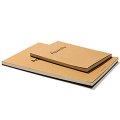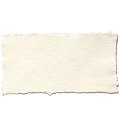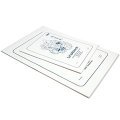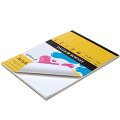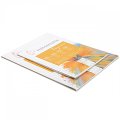Aquarelle Paper
Information about watercolour paper
Paper suitable for watercolouring must be absorbent to a certain degree, but also resistant to moisture so that the surface structure remains intact and no paper fibres come off. The paper must take on colour evenly and, if the surface is moistened, the colours must run smoothly into each other. These properties are primarily controlled by the sizing of the paper. Unsized paper (e.g. blotting paper) absorbs so strongly that it is hardly suitable for painting and writing on.
The higher the quality and thicker the watercolour paper is, the "wetter" one can work. But even the best watercolour papers warp and warp with one-sided wetting. Therefore, it is ideal to wet both sides evenly with a sponge before you start painting.
Our range of watercolour papers
Our handmade papers come from small paper mills where paper is still produced as before industrialisation. For this purpose, the fibres (usually cotton, but also flax, hemp etc.) are shredded in the so-called Dutchman and thereby broken down into cellulose. The pulp is then placed in a large vat (the vat) together with water and stirred well so that the fibres float in the vat and form a suspension.
When the paper is scooped, the papermaker dips the wire (a frame with a wire cloth applied) into the vat with the fibers evenly distributed in it and lifts it out again as soon as the appropriate amount of fibers floats above the dipped wire to produce a paper of the desired thickness. In a slightly different process, the aqueous fibre suspension is poured onto the wire, which is placed in a tub of water and evenly distributed on the wire surface. Handmade paper sheets are therefore always unique with irregular deckle edges in slightly varying formats.
For drying, the moist sheets are stacked between wool felt plates, then pressed and dried in the air. Depending on the intended use, the papers are still glued after drying, pressed again and dried in order to obtain a surface that, for example, accepts watercolour as desired. Papers with a rough surface take on the structure of the felt during pressing - this is known as "felt marking". Matt papers are pressed between zinc plates and thus obtain a smoother surface structure.
Khadi papers are produced in India by the "Khadi Paper Mill", which was founded in 1994 by young paper enthusiasts from England together with Indian partners to produce high-quality artist papers for the European market. Meanwhile Khadi Papers is the only Indian paper mill that is able to produce large handmade paper from rags (Cotton Rag) in best artist quality. In 2005, the mill employed over 50 people from the surrounding area. In addition, jobs were created in numerous trades closely related to the supply of the mill and the processing of its products.
At Khadi, however, the ecological concerns associated with paper production are also treated extremely conscientiously. This applies primarily to the water used, which is needed in large quantities for paper production - at Khadi up to 40,000 litres per day. It comes from the own well and is recycled up to 8 times before it is used for irrigation on the own farm. The fresh water is first used to produce the white paper, then for the light colours and then for the dark colours, and then for other simpler types of paper.
Of course, Khadi does not use chlorine or other bleaching agents. The dyes for the coloured papers come from European producers and comply with all German and European environmental standards. In addition, all papers in the mass are mixed with PH-neutral, synthetic glues. After drying, white papers are given an additional surface treatment with gelatine to create a perfect surface for watercolour painting.
Khadi only uses textile processed cotton sections from a nearby T-shirt factory for paper production, as these so-called rags (originally called "cotton rags") can achieve even better, firmer and more stable qualities due to the longer fibres than cotton linters, which come exclusively from cotton seeds. Please note this quality feature when comparing Khadi papers with handmade papers made from cotton linters.
Unlike many other papers made of wood pulp (cellulose), which are often marketed with the quality term "acid-free", Khadi papers are and will remain a quality mark for cotton linters.
The indicated paper sizes are guideline values, since genuine handmade paper has irregular deckle edges on all 4 sides. There is generally no running direction for handmade paper, as the paper fibres float chaotically in the vat and are accordingly absorbed by the sieve.
We expressly point out these quality characteristics, which are only rarely found today, as machine-made papers are also offered under the term "laid paper". The term "deckle edge" is also frequently used by other suppliers for torn paper with a fibrous edge.
In the following, terms will be clarified that appear again and again in connection with watercolour and other artist papers.
Alkaline buffered: Calcium carbonate (chalk) is added to the paper during gluing to ensure that it is permanently acid-free and thus resistant to aging. Calcium carbonate neutralizes acid pollutants from the air and ensures that the paper remains permanently alkaline.
Resistance to aging: The papers and boards designated as "highly resistant to aging" correspond to the highest service life class according to DIN 6738 and ISO 9706, i.e. they retain their essential properties of use for several hundred years. The aging of paper, which cannot be completely prevented, is delayed by the use of wood-free raw materials such as cotton fibres or alkaline pulp with a very low lignin content. In the production process of paper it is also important that the sizing is neutral and that calcium carbonate is added as a buffer against acids.
Genuine deckle paper: The name deckle paper comes from the "deckle", the large container in which the paper pulp is prepared and scooped with the sieve.
Only papers produced by hand or by machine using the cylinder mould scooping process may be described as genuine laid paper, because only in these two manufacturing processes does the edge of the laid paper form organically with the formation of the paper sheet. The characteristic deckle edge is created by diluting the wet paper pulp at the edge of the scoop sieve. Since the final format of deckle paper is determined by the format division on the screen, the deckle edges are always created on all four sides. Genuine deckle edges cannot be created or changed subsequently.
In contrast to the scooping process from a vat, the mixture of water and fibres is poured or sprayed onto an endless screen in the fourdrinier machine. Fourdrinier papers are always produced on rolls in an endless web and cut into sheets after production. Therefore, no real deckle edges can occur during this process. In addition, in the case of paper produced on the Fourdrinier Wire, the fibres orient themselves predominantly in the running direction of the wire. With cylinder mould papers, on the other hand, the fibres are distributed almost as evenly in the longitudinal and transverse directions as with hand-made papers, which results in high dimensional stability and dimensional accuracy of the paper sheet. These properties are particularly important for watercolour papers on which painting is carried out very wet.
Rags: Hadern (formerly textile rags, today the generic term for unwooden plant fibres made of e.g. cotton or linen) are the best starting material for paper production because of their long-chain fibres. Papers made of rags or with a rag content are more resistant to ageing and more robust than papers made of cellulose. In watercolour painting, paper containing rags is particularly useful when painting very wet.
Mass sizing: In mass sizing or fabric sizing, the sizing agent is added to the fibre pulp before the sheet is formed, so that uniform and complete sizing of all fibres is guaranteed. When painting, the ink can penetrate into the paper.
Neutral sizing: For paper to be resistant to ageing and acid-free, the sizing agent must be alkaline, i.e. its pH value must be above 7.0. By adding calcium carbonate (chalk), the paper remains permanently alkaline, which is the prerequisite for high ageing resistance.
Surface sizing: With surface sizing, the sizing agent is applied to the dried surface after completion of the paper sheet. Surface-glued paper allows ink to penetrate less quickly and allows more frequent corrections.
Cylinder mould machine: see "Genuine laid paper".
Acid-free: see "Neutral sizing". Detailed information can also be found in the Passepartout and Museum Board category.
